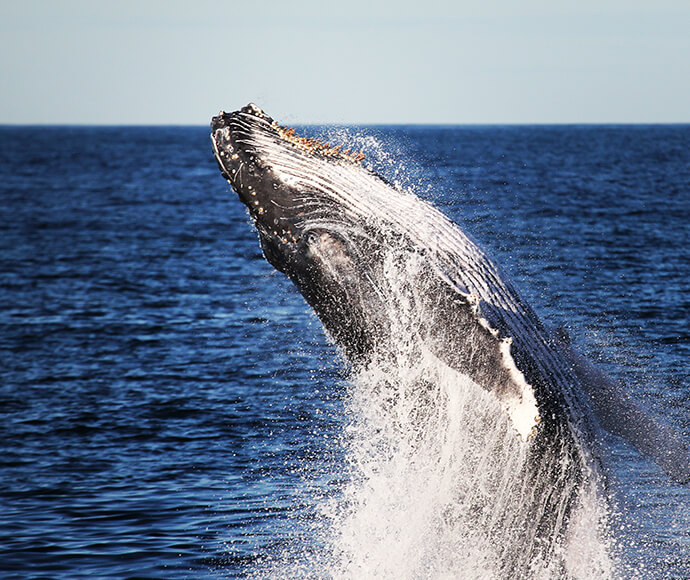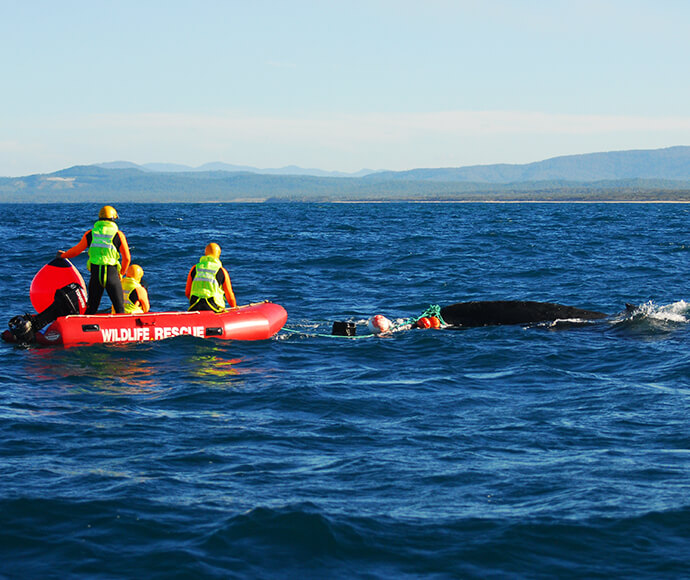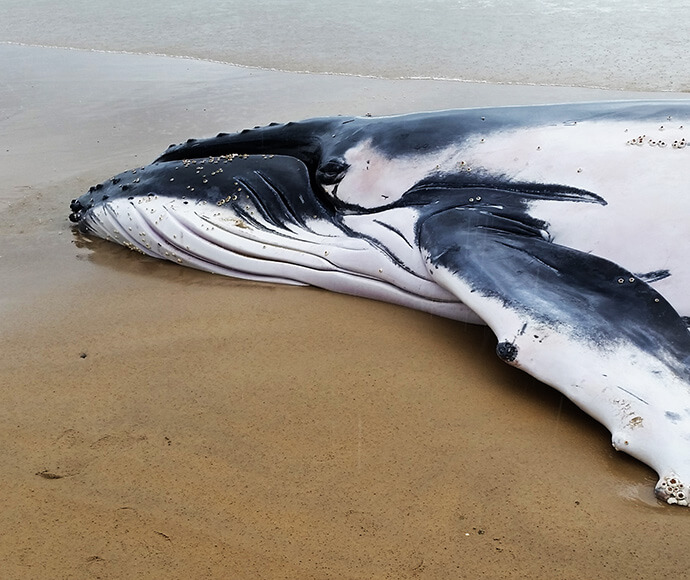Keeping your distance
Marine mammals are unpredictable and may unexpectedly lash out or try to get away if feeling threatened. People have been seriously injured after disturbing marine mammals who were resting or nurturing their young.
All animals need rest to survive. A humpback whale with her newborn calf wallowing in the protection of a sheltered bay or a fur seal hauled out on a beach after foraging at sea, are resting.
If you approach too closely, the animal will no longer rest. It will be keeping a watchful eye on you and may suddenly try to defend itself or go somewhere else, using up much needed energy reserves.
Going too close can cause animals to panic. Alarmed fur seals hauled out on rocks may panic stampede to get away, resulting in serious injury to adults and death to trampled pups.
Southern right whale mothers resting close to shore are known to aggressively keep intruders away from their calves or move on to another location, resulting in the young becoming weak from exhaustion as they try to keep up.
Marine mammals are protected in New South Wales. For many people, the sight of a seal or whale is still a novelty. Their populations are slowly recovering along the NSW coast after being hunted almost to extinction 2 centuries ago.
Despite the best intentions of curious onlookers, repeated and frequent disturbances put animals on edge and affect their health, wellbeing and survival. You can help them in their recovery by keeping back and allowing them to seek suitable places to rest undisturbed.
For your safety and the welfare of marine mammals, you should keep your distance.
Signs of disturbance
Disturbed whales, dolphins, dugongs and seals react with a sudden change of behaviour, including:
- hastily diving
- vocalising
- changes in breathing patterns
- sudden change in body posture or positioning
- a sudden change in direction
- a change in swimming speed
- aggressive behaviour such as tail splashing, head lunges and charging
- protectively moving between you and their young.
If you see someone intentionally harming, touching, harassing, chasing, trying to restrict the path of a marine mammal, or getting too close, please report the illegal activity to the National Parks and Wildlife Service on 13000PARKS (1300 072 757).
Approach distance
An approach distance is the closest you can lawfully go to a whale, dolphin, dugong or seal to watch it safely and without disturbing or harassing them, so they can live naturally and without interference.
Scientists, including veterinarians, helped to develop the Biodiversity Conservation Regulation 2017, which outlines the approach distances for New South Wales. These are based on the Australian National Guidelines for Whale and Dolphin Watching 2017 and also include seals.
Remember, if a marine mammal approaches you, slowly move back to at least the minimum approach distance. Never chase it, try to touch it or restrict its path. On a rare occasion, a National Parks and Wildlife Service officer may ask you to move back beyond the minimum approach distance if they see an animal is still distressed and behaving as if it is disturbed.
You can have a safe and enjoyable time while helping to keep our wildlife wild by observing the following approach distances:
When to call for help
Entangled whale, dolphin or seal
If you see an entangled animal:
- Watch from a distance. Do not approach or enter the water or attempt to disentangle it.
- Immediately report it to:
- the National Parks and Wildlife Service on 13000 PARKS (1300 072 757)
- Organisation for the Rescue and Research of Cetaceans in Australia on 02 9415 3333
- Note the time, your location, the animal's direction of travel and speed.
- Observe from a safe distance to:
- look for injuries and identifying marks
- take photographs of the entangling material to help rescuers bring the most suitable gear to remove it
- try to keep watch until help arrives.
Stranded, sick or abandoned animal
If you see a marine mammal on a beach that appears stranded, sick or abandoned:
- Immediately report it to:
- the National Parks and Wildlife Service on 13000 PARKS (1300 072 757)
- the Organisation for the Rescue and Research of Cetaceans in Australia on 02 9415 3333.
- Give precise location details, with distances and directions from the closest beach access or a prominent headland.
- Do not enter the water, go between the animal and the shore, or try to push it back out to sea.
- Never use a fin, flipper or tail as a handle to restrain, hold or push.
- Avoid the eyes, mouth and blowhole.
- Do not stand near or over the tail of a whale or dolphin, as a sudden reaction from the animal may result in you being struck with great force.
- While waiting for help to arrive:
- if it is a seal, it is most likely hauled out and just resting after foraging at sea
- keep at least 40 metres away
- do not approach the animal, even if it appears injured.
A seal is fast on land and may bite. If feeling threatened, it may show aggression by yawning, waving its front flipper or head or calling out.
If it is a dolphin or small whale, keep back to reduce its stress, keep others back and keep the noise levels low. Ask the National Parks and Wildlife Service or the Organisation for the Rescue and Research of Cetaceans in Australia responder how you can assist them while you are waiting. Whales and dolphins have lungs so can survive out of water for some time.
If asked to assist by a trained rescuer, watch out for your safety and that of others. The water can be cold and the animal heavy and unpredictable. Give plenty of space and keep noise to a minimum.


